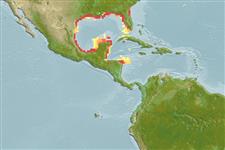分類 / Names
俗名 | 同種異名 | Catalog of Fishes(屬, 種) | ITIS | CoL | WoRMS | Cloffa
Teleostei >
Clupeiformes (Herrings) >
Dorosomatidae (Gizzard shads and sardinellas)
Etymology: Dorosoma: Greek, doris = lance + Greek, soma = body (Ref. 45335); petenense: Doro=meaning lanceolate; soma=body (referring to the body shape of the young), and petenense, for the type locality Lake Petén, Guatemala (Ref. 79012).
More on author: Günther.
Environment: milieu / climate zone / depth range / distribution range
生態學
海洋; 淡水; 半鹹淡水; 溯河洄游 (Ref. 51243); 深度上下限 0 - 15 m (Ref. 39049). 亞熱帶的; 20°C - 30°C (Ref. 115833); 42°N - 15°N, 159°W - 81°W (Ref. 188)
North and Central America: Gulf of Mexico drainage, Mississippi system, from the Ohio River of Kentucky and southern Indiana southwest to Oklahoma, and south to Texas and Florida, also rivers around the Gulf to northern Guatemala; also Belize River, British Honduras. Introduced in Hawaiian waters (Ref. 188) and in Chesapeake Bay tributaries (Ref. 93252).
中美洲與北美洲: 墨西哥灣流域,密西西比河流域,肯塔基州與印地安那州西南到俄克拉荷馬州南部的從俄亥俄河, 而且南至德克薩斯與佛羅里達, 也灣到瓜地馬拉北部的周圍河; 也宏都拉斯的貝里斯河。
Length at first maturity / 大小 / 重量 / 年齡
Maturity: Lm 5.2, range 5 - 5.5 cm
Max length : 33.0 cm TL 雄魚/尚未辨別雌雄; (Ref. 96339); common length : 10.0 cm SL 雄魚/尚未辨別雌雄; (Ref. 9291); 最大年齡: 4 年 (Ref. 12193)
背棘 (總數): 0; 背的軟條 (總數): 11-15; 臀棘 0; 臀鰭軟條: 17 - 27; 脊椎骨: 43 - 44. Body moderately deep; belly with 15 to 18 + 8 to 12 scutes. Mouth small. Last dorsal fin ray long, about equal to distance from snout tip to mid-pectoral fin or beyond; anal fin relatively short. Scales relatively large, regularly arranged. A dark spot behind gill opening. Gill rakers fine and numerous (Ref. 188). Body bright silvery, especially on sides, opercles and underparts. Back and upper sides bluish black or dark olivaceous (Ref. 37032).
身體中等縱深的; 腹面有 15 到 18+8 到 12個鱗甲。 嘴小的。 最後的背鰭鰭條長的, 大約等於從吻尖到在之中的距離-胸鰭或超過; 臀鰭相當短的。 鱗片相當大的, 規則排列的。 在鰓裂後面的一個深色斑點。 鰓耙細且多.(參考文獻 188) 身體明亮的銀色, 尤其在側邊,鰓蓋與下部上。 背面與上側面藍黑色或黑的橄欖色的.(參考文獻 37032)
Often schooling, occurring mainly in freshwater (in large rivers, reservoirs, lakes, and swamps). Prefer the presence of smooth, steep-sided surfaces such as dams, cement-lined pools and rip rapped streams (Ref. 39049). But adults are also found in brackish or saline water of estuaries and bays (up to 32.3 ppt salinity (Ref. 39050); juveniles to about 15 ppt). Larvae are pelagic probably found only in freshwater (Ref. 39046). Filter-feeders, but not entirely herbivorous since recorded food items include copepods, cladocerans and fish fry. Also feed on organic material of sand and detritus bottoms (Ref. 9114). Breed in the spring and in autumn, in freshwater, near or over plants or other objects. Eggs adhere to aquatic vegetation (Ref. 4639). Caught exclusively in fresh waters and sometimes in mouths of rivers (Ref. 9291). Also Ref. 58302.
時常群游, 主要出現在淡水。 (在大河,水庫,湖與沼澤中) 偏愛平靜,邊緣有大落差的表面例如水壩, 內襯水泥的水池,而且裂痕輕敲.溪流。 (參考文獻 39049) 但是成魚也被發現於半鹹淡水或鹽河口與海灣的水 (向上到 32.3個 ppt 鹽度;(參考文獻 39050) 稚魚到大約 15個 ppt). 仔魚是大洋性的可能發現只在淡水中.(參考文獻 39046) 濾食動物, 但是不是完全食草自從記錄的食物組成之後包括橈腳類的動物,水蚤與魚苗。 也吃砂與碎岩底部的有機物。 (參考文獻 9114) 在春天繁殖與秋天時, 在淡水中, 接近或就植物或其他的目標。 卵黏附在水生植物。 (參考文獻 4639) 只有在淡水捕獲.與有時在河口中.(參考文獻 9291) 也參考文獻 58302.
Life cycle and mating behavior
成熟度 | 繁殖 | 產卵場 | 卵 | 孕卵數 | 仔魚
Breed in spring and again in autumn, in open waters near or over plants or other objects; eggs slightly adhesive (Ref. 188). Females can produce 5,000 to 20,000 eggs depending upon their size (Ref. 44091).中美洲與北美洲: 墨西哥灣流域,密西西比河流域,肯塔基州與印地安那州西南到俄克拉荷馬州南部的從俄亥俄河, 而且南至德克薩斯與佛羅里達, 也灣到瓜地馬拉北部的周圍河; 也宏都拉斯的貝里斯河。
Whitehead, P.J.P., 1985. FAO Species Catalogue. Vol. 7. Clupeoid fishes of the world (suborder Clupeoidei). An annotated and illustrated catalogue of the herrings, sardines, pilchards, sprats, shads, anchovies and wolf-herrings. FAO Fish. Synop. 125(7/1):1-303. Rome: FAO. (Ref. 188)
人類使用
漁業: 低經濟; 誘餌: usually
更多資訊
合作者照片Stamps, Coins Misc.聲音神經毒速度泳型鰓區Otoliths腦重體重比眼睛色素
工具
特別的報告
下載 XML
網路資源
Estimates based on models
Preferred temperature (Ref.
123201): 23.3 - 28.1, mean 25.5 °C (based on 182 cells).
Phylogenetic diversity index (Ref.
82804): PD
50 = 0.5312 [Uniqueness, from 0.5 = low to 2.0 = high].
Bayesian length-weight: a=0.00912 (0.00560 - 0.01485), b=2.97 (2.83 - 3.11), in cm total length, based on LWR estimates for this species & (Sub)family-body (Ref.
93245).
營養階層 (Ref.
69278): 2.8 ±0.1 se; based on diet studies.
回復力 (Ref.
120179): 中等的, 族群倍增時間最少 1.4 - 4.4年 (tm=1-2; tmax=4; Fec=800).
Fishing Vulnerability (Ref.
59153): Low vulnerability (23 of 100).
Nutrients (Ref.
124155): Calcium = 116 [71, 204] mg/100g; Iron = 1.74 [1.04, 2.98] mg/100g; Protein = 19.5 [18.4, 20.6] %; Omega3 = 0.499 [0.289, 0.845] g/100g; Selenium = 14.5 [7.5, 28.1] μg/100g; VitaminA = 18.6 [7.2, 48.4] μg/100g; Zinc = 1.18 [0.82, 1.68] mg/100g (wet weight);
